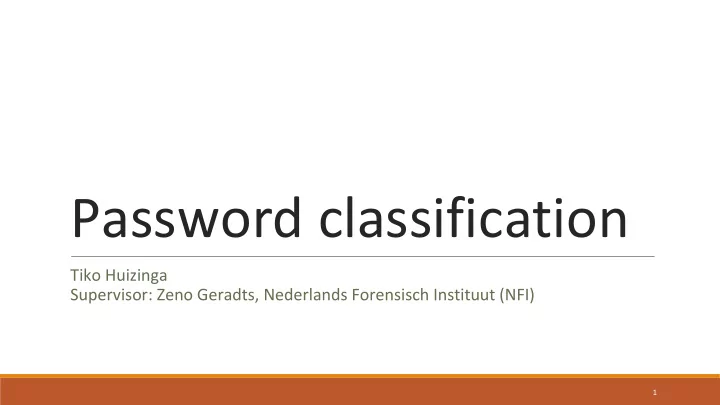

Password classification Tiko Huizinga Supervisor: Zeno Geradts, Nederlands Forensisch Instituut (NFI) 1
Example case ● Police confiscates hard drives ● Fast (automatic) analysis of data needed ● Saved plain text passwords can be very useful 2
3
Hansken ● Search engine for Dutch police and forensic institute ● Machine learning and image classification ● No password classification yet ○ This is where my research jumps in 4
Research question ● How can software be used to classify whether a string is a password or a “normal” word? 5
Scope ● The input for the tool are text files containing one or mul7ple words ● A word is the string between a star7ng and ending space or newline ● As a result, the tool does not classify passwords containing a space ● English language is used for training the tool 6
Method ● Gather data ○ Password list ○ Word list ● Generate statistics ○ Length, #Digits, #Special characters, … ● Create naive probabilistic classification tool ● Use machine learning to create classification tool ○ Support Vector Machine (SVM) ● Evaluate both tools ○ Precision, Accuracy, F1-Score 7
Data gathering Started with ● Common passwords English wordlist ○ Common credential list ○ English dictionary wordlist 123456 abac Too ‘boring’ ● ○ Not a lot of special characters and no password abaca unique passwords New password list ● ○ Breach compilation 12345678 abacay ○ Unique passwords New word list ● qwerty abacas ○ Partial Wikipedia dump ○ Represents text files on computers 8
Generate statistics Gather characteristics for all words ● ○ Length ○ # Special characters ○ # Digits ○ # Capital letters ○ # Small letters 9
Length of passwords and words 10
Number of digits Passwords Words 11
Naive probabilistic classifier Class C = {Password, Word} Characteristics X = { Length, #Special characters, #Digits, #Capital letters, #Small letters} pw(x) = Number of passwords with characteristic x / total number of passwords w(x) = Number of words with characteristic x / total number of words 12
Naive probabilistic classifier If result >= 0.5 ● ○ Classify as password Else ● ○ Classify as word 13
Support Vector Machine (SVM) Machine learning classification ● Divide data in two classes ● Find hyperplane with largest margin ● 14
Metrics and evaluation of classifiers Confusion matrix 15
Metrics and evaluation of classifiers 16
Metrics and evaluation of classifiers 17
Metrics and evaluation of classifiers ● F1 score ● The harmonic mean of Precision and Recall 18
Evaluation of classifiers Naive probabilistic classifier SVM Class Precision Recall F1-score Class Precision Recall F1-score Word 0.93 0.89 0.91 Word 0.79 0.91 0.85 Password 0.89 0.93 0.91 Password 0.89 0.74 0.80 19
Conclusion ● How can software be used to classify whether a string is a password or a “normal” word? ○ A naive probabilistic classifier achieves good results with an F1 score of 0.91 ○ A Support Vector Machine trains slower and achieves a lower F1 score with 0.80 and 0.85 20
Discussion ● The results are very dependant on the training set and test set ● SVM probably scores worse because there is no clear line separating passwords from words ● I used lists with all unique words with all the same weight ○ Giving more frequent words a higher weight might bring the model closer to reality 21
Future work ● Use more characteristics ○ Place of special characters in string ● Use different (machine learning) classification algorithms ○ Decision trees ○ Bayesian networks ○ SVM with different parameters 22
Thank you! 23
Recommend
More recommend